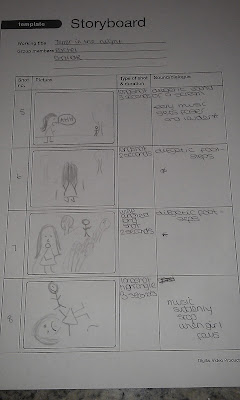- Transitions: shot lengths/style/speed of transitions.
- Mise-en-scene representing the genre
- Technical codes to show gender superiority/ weakness
- Sound including a sound bridge
- Camera: Angle/framing/ movement.
This is what my partner and I created.

After creating our storyboard we were told we'd have to pitch our idea to one of our teachers which meant trying to prove our movie would be worth investing in hypothetically.
In addition, we were given the opportunity to listen and learn from a professional storyboarder and animator who gave us some top tips for when we have to draw a storyboard. For example, she taught us that instead of drawing the storyboard in the correct order, it can sometimes be easier to draw random, key ideas first in order to to get some ideas on to paper. Furthermore, we were also taught the rule of thirds, where a grid of 9 squares is drawn over the frame. This allows you to take time over thinking about where you should place items and characters within the frame because anything placed in the center of the frame is supposedly more noticeable to an audience.
This has been very useful in adding to my knowledge and understanding of storyboarding because I will be able to use these techniques to help me when drawing a storyboard in the future. In addition, it has given me some practice on how to storyboard which means if I come across any mistakes I will be able to learn from them in order to progress.

No comments:
Post a Comment